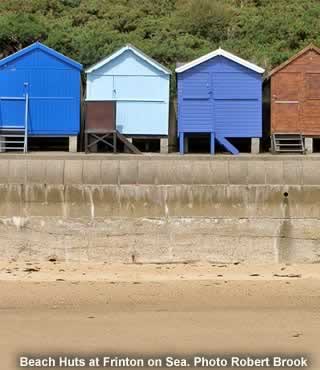Frinton on Sea |
|
 |
|||
A fashionable seaside town that grew up during the late Victorian era |
Just up the coast from the famous seaside resort of Clacton-on-Sea, you'll find the similarly-named Frinton-on-Sea. This town is a relatively new settlement; it grew up in the late Victorian era. It soon became a fashionable place, with people like Winston Churchill and the Prince of Wales being frequent visitors. |
Some seaside towns like the neighbouring Clacton - try to lure in the tourists like moths to a flame, with all sorts of flashing lights and noises. Frinton, on the other hand, does no such thing. It has very few brand name shops, very few ice cream vendors, and no tourist information centre. It only acquired its first pub in the year 2000, which remains the only one in town. Nevertheless, it offers an atmosphere that isn't easy to find in a British seaside town. |
Frinton's main entranceway is via its railway gate. This used to be made of wood, and was something of a town landmark. Recently though, despite opposition from the locals, it was replaced with a more modern, electronic gate. Still, the entrance still leads to the same place. Follow the road south, and you'll be on Connaught Avenue, the town's main drag. Its stylish independent shops have earned it the nickname: The Bond Street of East Anglia. |
The street leads to the beach, which is over a kilometre-and-a-half long. It's lined with Victorian beach huts, of which there are several hundred. The sands here have an unusual appearance, for two reasons. The first is that it's divided into narrow sections by low walls, to help stop erosion. The second is that it's usually completely litter-free, thanks to the complete lack of vendors selling ice cream, fish and chips, or similar goods. It's a non-commercial place, that's both quiet and relaxing. |
If you find yourself missing the usual trappings that go hand-in-hand with most beaches in Britain, but still don't want to venture towards the brash sights and sounds of Clacton, then you might enjoy a walk up to Walton-on-the-Naze. This neighbouring town doesn't go over the top, but it has made a few concessions to commercialism. |
The most obvious example is Walton Pier. It was built in 1830, making it one of the UK's first. After a few extensions, it became the third-longest in the country reaching an impressive length of 793 metres. Originally, the pier was used as a landing point for boats and steamers, and not as an entertainment centre. Things are a little different now though, as it has plenty of rides, a bowling alley, and other attractions. All of the amusements are indoors, making the pier a good place to hang out on rainy days. If the weather's good, then it's worth walking outside to the end of the pier, which has particularly good views back towards the beach. This is also a popular spot for a bit of sea fishing. |
Another good spot to walk to is the promontory to the north. It's a small nature reserve with lots of migrating birds. In old English, a promontory like this was known as a Naze, which explains the town's name. The word Naze is also commonly associated with the Naze Tower, one of the town's most recognisable landmarks. The tower was built in 1720, and was intended to help ships when they were navigating the coast. It has since been converted into a museum and art space. Over the tower's 8 floors, there are exhibits and artworks, as well as a tearoom, and an open air viewing platform at the summit. |
|
Pocket Britain is optimised for use on a smartphone or tablet with internet access. All content is subject to copyright. All reasonable methods have been used to ensure information supplied is accurate at the time of publication. However, it is advisable to check information before relying on it. Privacy Policy |